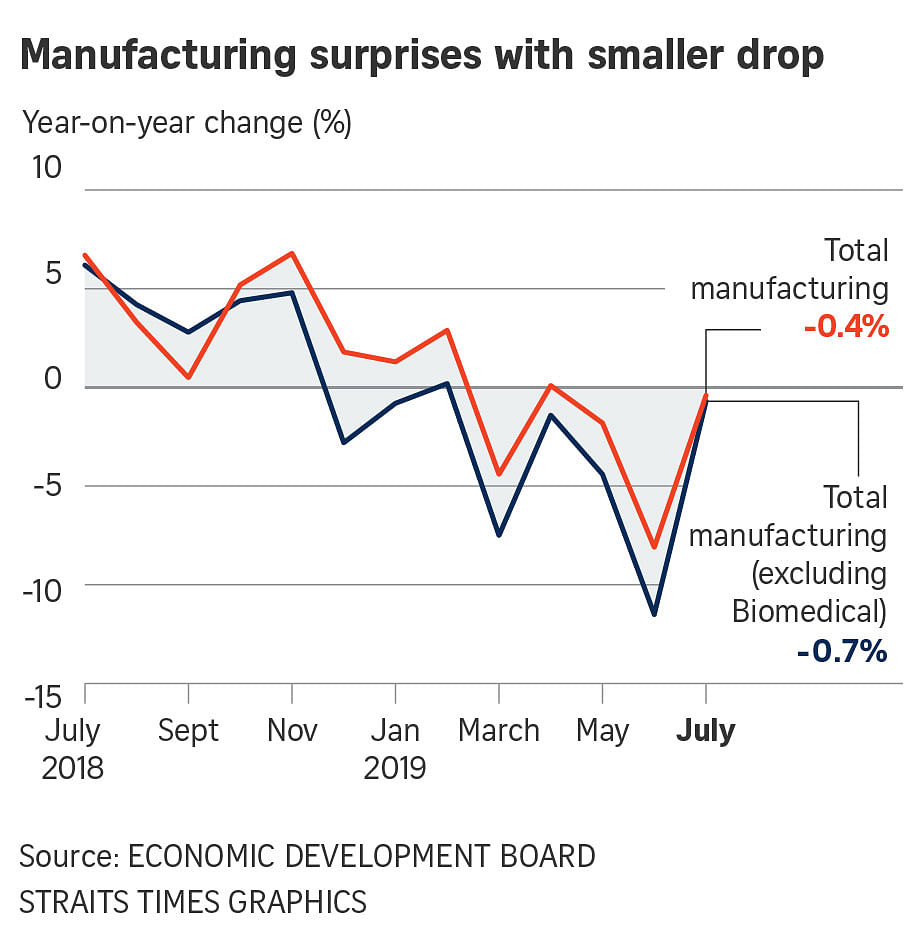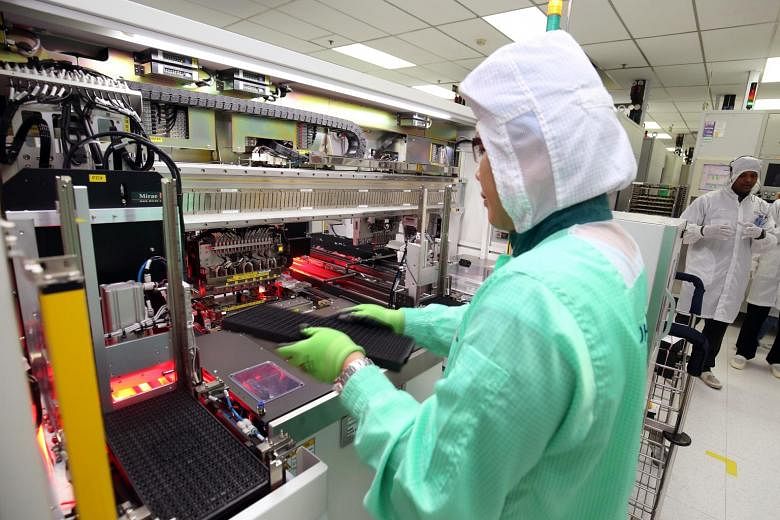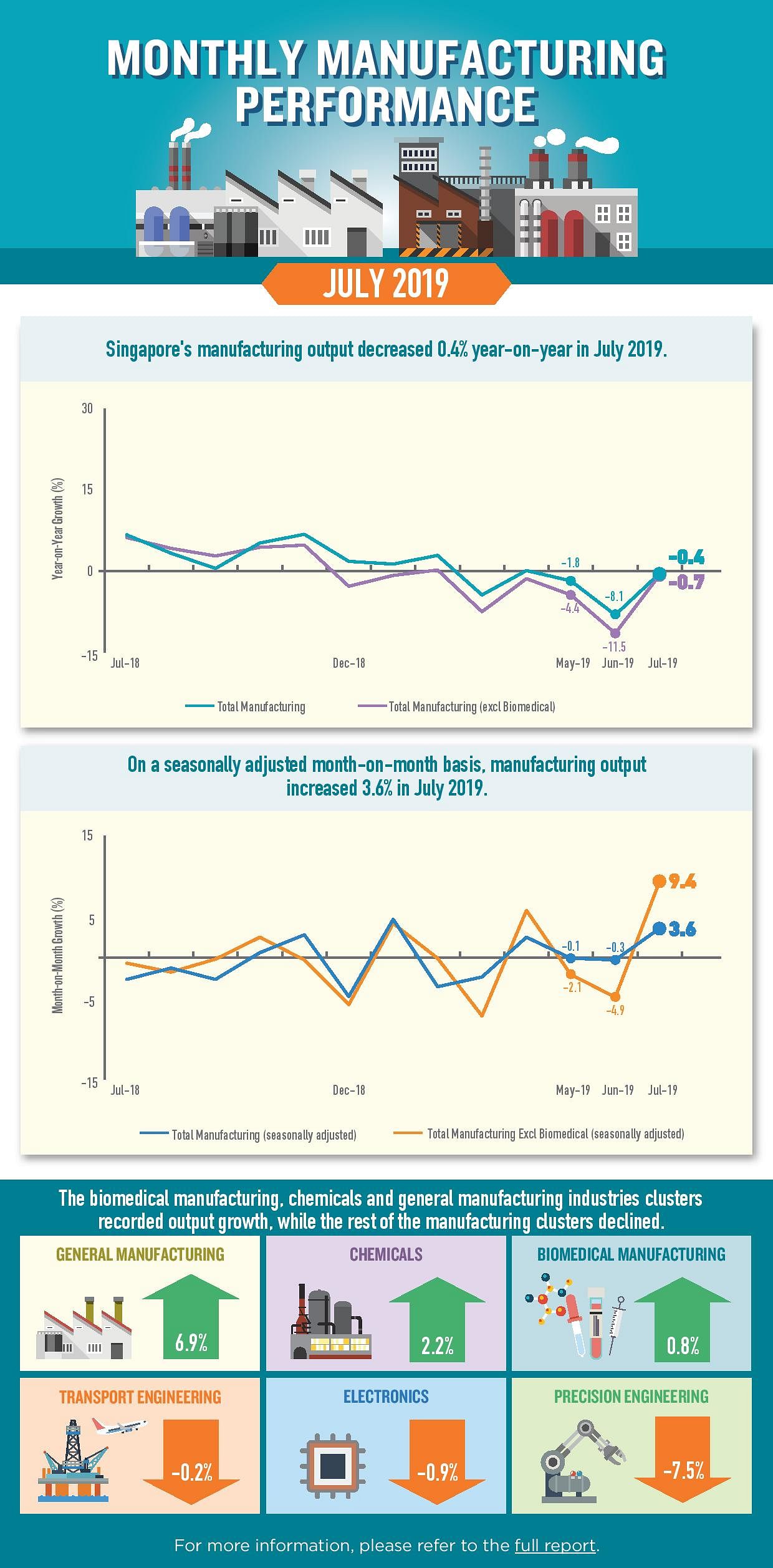SINGAPORE - Singapore's manufacturing output last month (July) contracted for the third consecutive month, but beat analysts' forecasts by a mile with a decline of just 0.4 per cent over July last year.
Analysts polled by Bloomberg had expected a 5.8 per cent slump. The sector's performance last month also improved markedly from the 8.1 per cent plunge in June, which had been the sector's worst showing in 3 1/2 years.
June's figure was revised downwards from the previously reported contraction of 6.9 per cent.
Excluding the volatile biomedical manufacturing sector, the fall in output last month was slightly steeper at 0.7 per cent, according to preliminary figures released by the Economic Development Board (EDB) on Monday (Aug 26).
On a seasonally adjusted month-on-month basis, overall manufacturing production increased 3.6 per cent. Excluding biomedical manufacturing, it grew 9.4 per cent.
Analysts had mixed views on what the latest figures mean for the risk of a technical recession in Singapore, in light of the escalating trade war between the United States and China.
UOB economist Barnabas Gan sees manufacturing output stabilising this quarter. He said: "The better-than-expected industrial production growth pace in July reinforces our view for Singapore to evade a technical recession scenario in (the third quarter)."
But Maybank Kim Eng economists Chua Hak Bin and Lee Ju Ye expect a technical recession to come. They said the next wave of US tariffs in September and December will be more destructive for global electronics demand as a larger proportion will be on consumer goods, especially electronics, versus the first wave.

There was an improvement in the the key electronics sector in July - which makes up over a quarter of factory production here. It contracted by 0.9 per cent last month year on year, far better than the 18.2 per cent fall in the previous month.
The semiconductors segment rebounded with 0.3 per cent growth in output, after a drop of 21.4 per cent in June. The data storage segment also grew, while the rest of the segments such as computer peripherals and infocomms and consumer electonics shrank.
From January to July, electronics output was down 5.6 per cent, compared with the same period last year.
Several analysts like DBS senior economist Irvin Seah said it remains to be seen whether the improvement is due to frontloading of orders or a sustainable increase in demand.
Mr Seah added that although growth in the global semiconductor equipment order book turned around recently, which could suggest the light at the end of the tunnel for this cluster, "the most recent developments in the trade disputes between the US and China have once again cast a shadow on that hope".
US President Donald Trump on Friday announced additional tariffs on some US$550 billion (S$764 billion) in targeted Chinese goods, hours after China unveiled retaliatory tariffs on US$75 billion worth of US goods.
The EDB data for July showed that general manufacturing was the best performing cluster, with output growing by 6.9 per cent compared with a 0.8 per cent decline in June. This included a 10.8 per cent jump in production by the miscellaneous industries segment on account of higher output of metal tanks and containers and wearing apparel, as well as a 7 per cent expansion in the food, beverages and tobacco segment with higher output of beverage products.
From January to July, general manufacturing grew by 2.9 per cent, compared with the same period last year.
Output from the biomedical manufacturing and chemicals clusters also grew last month, by 0.8 per cent and 2.2 per cent respectively. These industries grew 8.3 per cent and 0.2 per cent respectively in the first seven months of this year, compared with the same period last year.
But precision engineering weighed down the overall sector's performance. Output fell 7.5 per cent compared with July last year, with the machinery and systems segment shrinking while the precision modules and components segment grew on the back of higher output in optical products.
Transport engineering production also shrank by 0.2 per cent, as declines in land and marine and offshore engineering outweighed the growth in aerospace.
Precision engineering and transport enginering shrank 8.7 per cent and 0.8 per cent in the first seven months of this year, compared with the same period last year.



